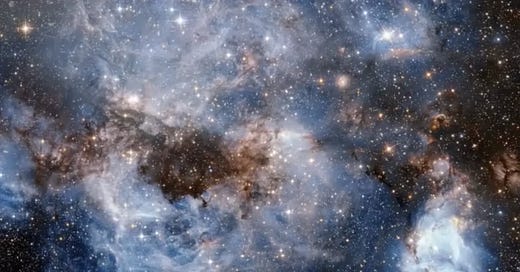Question #3: When did the Universe Begin? (For previous posting: click here)
The answer to the question of when the Universe began is provided by the current Big Bang model: 13.8 billion years ago. This question is similar to the ones already asked: why is there something instead of nothing and what is space-time. These are human constructs as pointed out by Stephen Hawking in his reputed reply to a similar question: what happened before the beginning of the Universe and his reply was - what is north of the North Pole?
Cosmology is not like other sciences. It is not like watching chemical reactions in a beaker or rats in a maze in a lab. The universe is everything there is and we can’t stand outside the universe and observe it. It is all encompassing, cosmic forces action upon the scientists doing the experiments and on the observations that they make.
This reminds me of the 1st verse of the Tao Te Ching:
The TAO that can be spoken of is not the TAO itself.
A description of the TAO would require a duplication of the TAO.
Similarly, a full description of the Beginning of the Universe would require a duplication of the Universe. There is a fixed and precise sequence of events that followed the Big Bang: first, the force of gravity pulled together denser regions of the cooling cosmic plasma, which grew to become stars and black holes; then the force of gravity pulled together the stars into galaxies.
But since there wasn’t enough “normal” matter to hold the individual spiral galaxies together we introduced cold dark matter (λCDM) and since the universe was expanding we needed dark energy. Consequently “normal” matter — the stuff that makes up people and tables and chairs and planets —constitutes only about 4 percent of the universe and dark matter 27 percent and dark energy 68 percent.
The beginning of the universe was arrived at by using the Hubble expansion (red shift) of the universe and running it backwards to a point when everything was at the same place — the so-called singularity — 13.8 billion years ago. However, we may have come to the point where we need a radical departure from this standard model. We may even require a rethink of the elementary components of the universe, and our concepts of space and time.
Another problem with the model was that the universe was expanding at an increasing rate according to the Hubble constant. This was the starting point of more questions about the Big Bang model. Furthermore, observations from the James Webb Space Telescope (JWST) beamed back stunning images of small and distant galaxies made it necessary to rethink the key features of the origin and development of the universe. The JWST revealed that some very large galaxies formed really fast in a short period of time and that some distant galaxies were too small and too smooth. The story of our universe is beginning to unravel.
But we have had previous revolutions in science like Copernicus’s heliocentrism — threatening our special place in the cosmos, or Darwin’s theory of evolution — challenging our idea that we are different than other animals, and Einstein’s space-time relativity — upending our common sense ideas about the flow of time.
It is not obvious what revolutionary considerations might help us better understand the cosmological data that is flummoxing us. Part of the problem is that the “data” is itself is shaped by theoretical assumptions of those who collected them. We need more than tweaks and adjustments to do the trick, we may need not just a new story of the universe but according to the philosopher Robert Crease, a new way to tell the story.
Here is a video clip of the unfolding story.
(This video contains excerpts from YouTube videos: www.youtube.com/watch?v=oG7SRdu1F18 and www.youtube.com/watch?v=3Z1V7FLjx9g.)
This brings us to the next question: Question #4 —is our perception of the cosmos a “controlled hallucination” as per Anil Seth?



